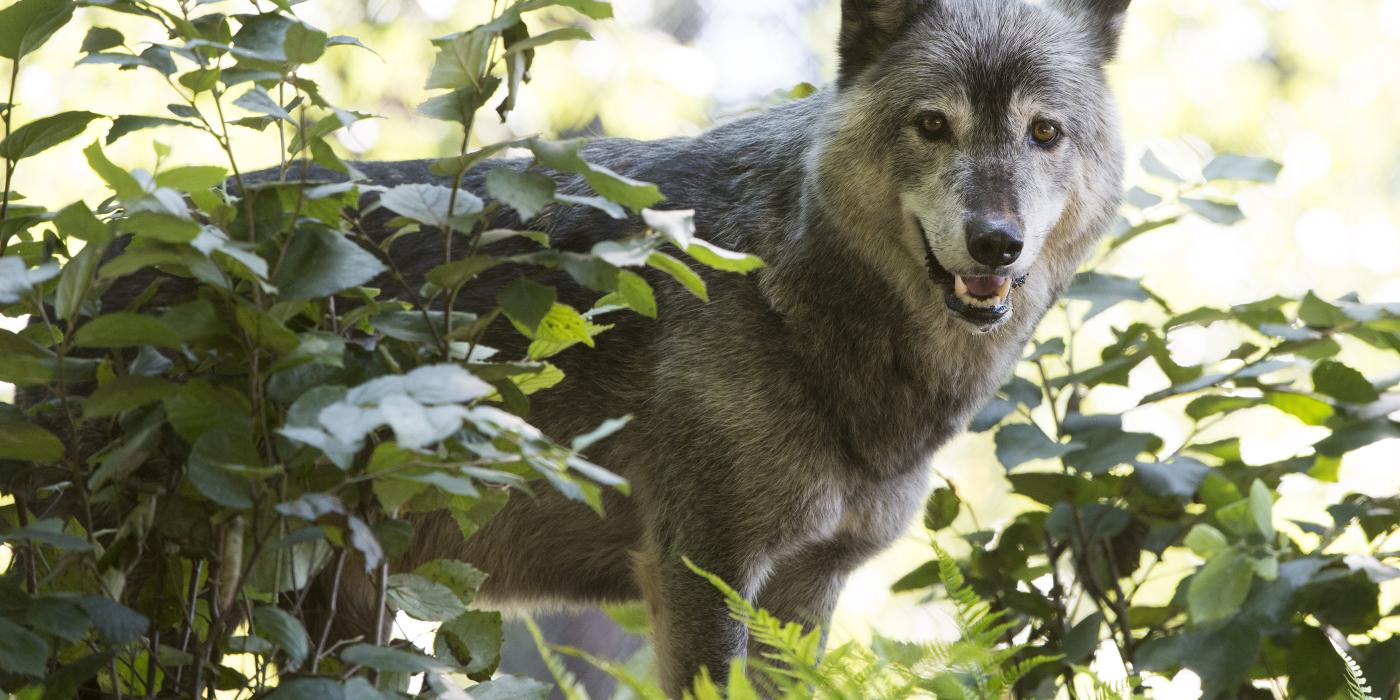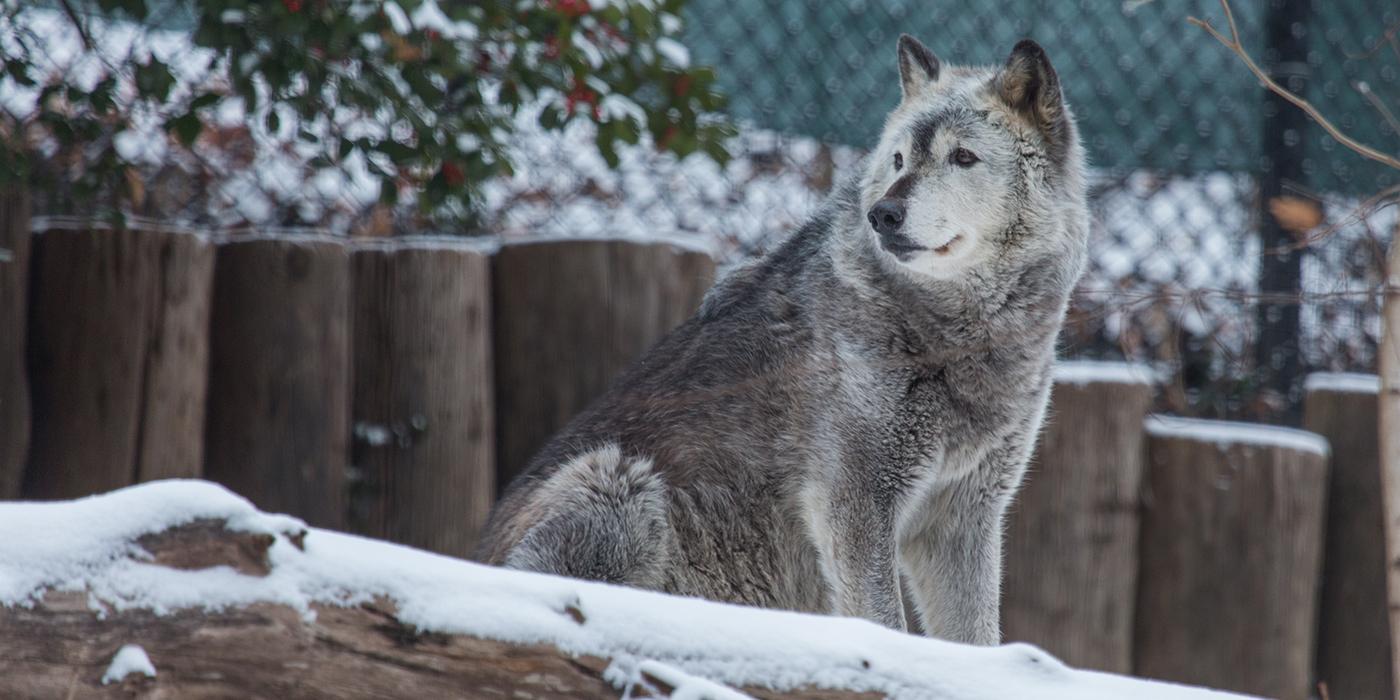The gray wolf, also called the timber wolf, is the largest member of the canine family with fur ranging from gray to brown, black or white. Packs of gray wolves hunt at night, using their speed, sharp teeth and claws to catch caribou, moose, deer, bison, beavers, rabbits and fish.
Physical Description
Depending on habitat location, the coloration of gray wolves can range from white to black with the majority exhibiting light brown or gray coloration. Their coloration provides camouflage while hunting. Being hidden is helpful when packs of wolves hunt at night to catch prey as a team, or lead prey into the remaining members of the pack as a trap.
Size
The largest members of the canine family, male wolves weigh males between 65 and 175 pounds (30 to 80 kilograms) and females weigh between 50 and 120 pounds (23 to 55 kilograms). They measure from 4 feet 3 inches to 6 feet 9 inches (130 to 205 centimeters) in total length.
Native Habitat
Historically, aside from humans, gray wolves had the greatest natural range of living terrestrial mammals. More recently, their distribution has been restricted to the open tundra and forests of North America, primarily in Alaska, Canada and the northern United States. Gray wolves are highly adaptable and have been known to survive in all habitats in the Northern Hemisphere except for tropical forests. Gray wolves maintain a stable population growth in these areas regardless of varying densities.
Lifespan
In the wild, gray wolves can live between seven and eight years and up to 20 years in human care.
Communication
Gray wolves have a variety of visual, olfactory and auditory means of communicating. Vocalizations include growls, barks and howls. Different individuals have different howls that can be heard by other wolves at distances of 6 to 7 miles (10 to 11 kilometers). Howling functions as a way to keep the pack back together, stimulate a hunt and as a long-distance form of territorial expression. Howling can also return a lost wolf to its pack.
A "lonesome howl" is a shortened call that rises in pitch used by a wolf that is separated from its pack. If answered, the wolf switches to deep, even howls to inform the pack of its location and help it to be found. Howling increases during breeding season (January through April). Scent marking via scratching, defecation and urination are all means of maintaining pack territories.
Body language is a tool of communication for the wolf. Just as human postures and gestures express our intentions and feelings, the wolf also uses body language to communicate.
Dominant postures may include a partly erect tail, walking with the head held high and eyes directed straight towards other wolves. Dominant wolves may show raised hackles, and may also side-swipe or slam into the subordinate members of the pack. They may also growl, show bared teeth, a wrinkled forehead, and their ears may stand erect and pointed forward. They are usually first to eat at a kill. A dominant wolf may "ride up" on a subordinate wolf by placing its head or forelegs across that animal's shoulders.
Subordinate postures include lowered tails, a lowered body position, an exposed throat, small steps towards more dominant members, a peeling back of lips, ears folded back and can include urination while crouching or urination on themselves. They may also raise a hind leg to expose the groin area.
Food/Eating Habits
High speeds help wolves catch up to their prey while a wolf's sharp teeth and claws finish the job.
The gray wolf is a keystone predator and is integral to the ecosystem in which it is found. Gray wolves hunt cooperatively in packs and are able to take down prey larger than they are including caribou, moose, deer and bison. Wolves will also occasionally catch smaller prey such as beaver, rabbit, and fish, and will sometimes eat berries. Gray wolves eat around three to four pounds of food per day.
At the Smithsonian's National Zoo, the wolves are fed a mixture of dry canine kibble, meat, fish, bones, frozen prey (mostly rabbits) and vegetables.
Social Structure
The gray wolf is among the most social of carnivores. Wolf packs typically have five to eight wolves, but packs with as many as 36 wolves have been reported. The pack is essentially a family group consisting of an adult pair, called the dominant pair, and their offspring. The dominant pair usually initiates activity, guides movement and takes control at critical times, such as during a hunt. Essentially, the mother and father are teaching the rest of the pack how to hunt, survive, avoid threats and mark territory.
A wolf pack's dominant pair sometimes mate for life. They are typically the only wolves that mate within a pack, and they inhibit the sexual activity of others. The other wolves may have separate dominance hierarchies, reinforced by aggressive behavior and elaborate displays of greeting and submission by subordinate members. A pack leader may retain his position as the dominant male for years, but strife from increasing pack size or declining food supplies can result in the division of a pack or the splitting off of individuals.
Reproduction and Development
In a pack, typically only the dominant pair mates. Mating may occur anytime from January to April with births taking place in spring. Courtship can last for days or months with estrus lasting five to 15 days. The gestation period is 62 to 63 days with an average litter size of six.
At birth, wolf pups weigh about 16 ounces (450 grams) and are blind and deaf. After 11 to 15 days, their eyes open. They emerge from the den when they are 3 weeks old. Dens may be in rock crevices, hollow logs, or overturned stumps, but are usually in a burrow, either dug by the parents themselves or initially made by another animal and enlarged by the wolves. These tunnels, or maternity dens, are one of the only ways wolves will seek shelter, and the same den may be used repeatedly for years.
Depending on a variety of factors, a young wolf may stay with its parental pack or go out on its own. As a young wolf reaches maturity around 2 years of age, it may actively explore the fringes of its parental territory prior to leaving. Once a young wolf has left the pack it will either join another lone wolf in order to search for new territory, or it will establish itself in an area and wait for an animal of the opposite sex to arrive. Entering breeding age around 3 years old, a lone wolf may form a new pack with a member of the opposite sex.
Conservation Efforts
The International Union for Conservation of Nature list the status of the overall population as being of least concern, however the United States Fish and Wildlife Service lists six different populations with statuses ranging from Endangered to Delisted due to recovery. They are also listed under Convention on the International Trade in Endangered Species (CITES) Appendix II, which lists species that are not necessarily now threatened with extinction but that may become so unless trade is closely controlled.
There are currently 39 described sub-species of gray wolf including the dingo and the domestic dog, although there is a great deal of dispute surrounding some classifications. Each subspecies varies in range, appearance and conservation status. Information listed here refers to populations in the Western United States.
Gray wolves once had one of the largest natural ranges of any terrestrial mammal in the Northern Hemisphere. Human expansion into the Western United States placed wolves and humans in conflict from the outset. Cattle ranchers believe wolves to be a threat to their livelihood and a history of hunting and poisoning wolves has devastated populations, bringing the wolf to near extinction.
The Endangered Species Act of 1973 helped reestablish wolf populations by providing legal protection from the unregulated killing of gray wolves by humans. The wolf population has stabilized due to a combination of factors including legal protections, human migration to more urban areas, and land-use changes. In 1995, gray wolf populations were reintroduced in the northern Rocky Mountains and reached a successful population size by 2010.
A major threat to wolf recovery plans is the continued perceived threat to human safety. Wolves have long been portrayed in folklore as animals to be feared and this perception continues to be a challenge in modern times. Many still believe that increasing the size and distribution of wolf populations will lead to an increase in wolf attacks on humans and livestock. Even in areas with large wolf populations, attacks on humans are extremely rare. While attacks have occurred in Eurasia, there have only been four reported attacks in North America, none of which resulted in death.
Competition relating to livestock remains a major concern, and various efforts have been made by conservation groups to lessen this competition such as creating programs to compensate ranchers for the loss of livestock by wolves and installing deterrent systems. Although reintroduction programs have been successful, debate over de-listing certain wolf populations continues as threats from local and state governments to reinstate hunting and bounty programs persist.
While wolf populations are stable globally with an estimated 200,000 in 57 countries, wolves still face many threats. Conflict with people over livestock losses, human encroachment into wolf habitat, and the overall misunderstanding of the species remain serious threats to gray wolves. Opposing political, legislative, and conservation efforts continue whether the concern is for the safety and protection of the species, or their removal.
Help this Species
- Support organizations like the Smithsonian’s National Zoo and Conservation Biology Institute that research better ways to protect and care for this animal and other endangered species. Consider donating your time, money or goods.
- Share the story of this animal with others. Simply raising awareness about this species can contribute to its overall protection.
Animal News

Leaf-tailed Gecko Treated for Skin Cancer With Chemotherapy




